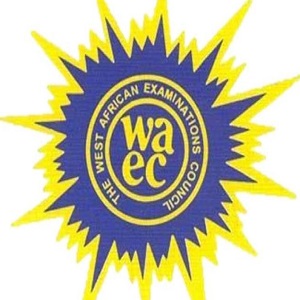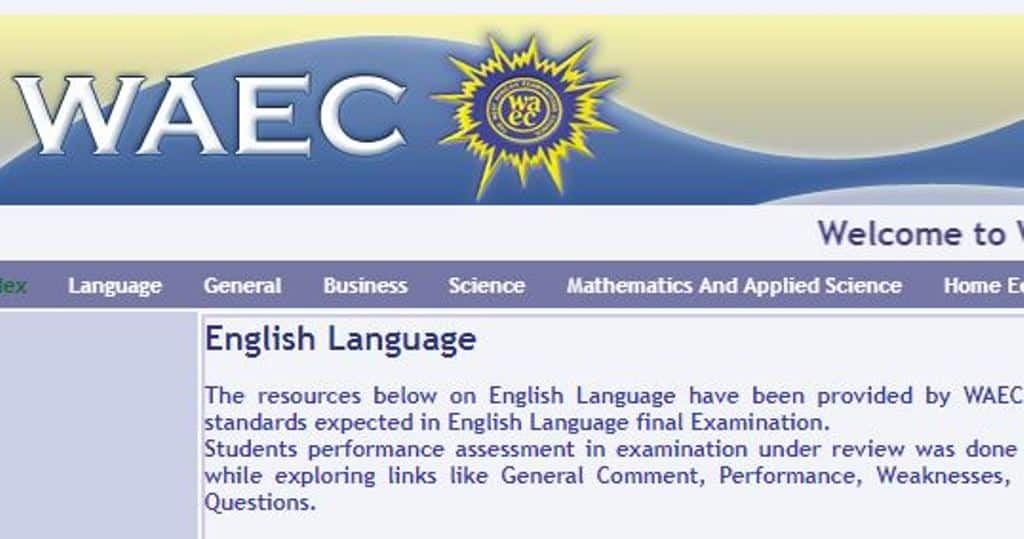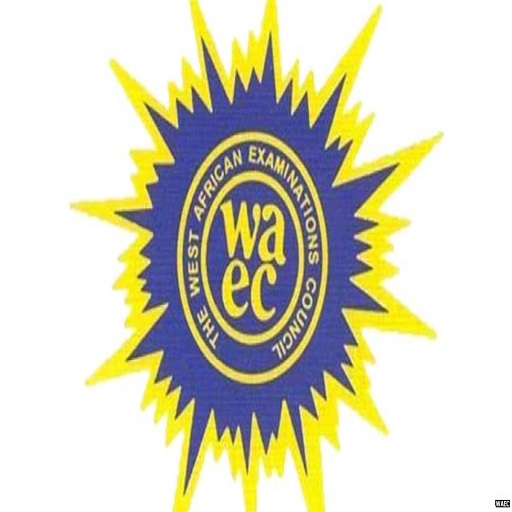Are you search for 2023 WAEC biology Past Question Paper? WAEC 2023 biology Past Question Paper? WAEC biology Questions and Answers 2023? WAEC biology Past Questions 2023? If yes, then your your search ends here.
ALSO SEE:
- WAEC Syllabus for biology 2022/2023 PDF
- WAEC Syllabus for All Subjects 2022/2023
- WAEC Biology Past question 2022
- WASSCE BIOLOGY PAST QUESTION PAPER 2020 PDF – PRIVATE CANDIDATE
- JAMB Syllabus For Biology 2023/2024 – JAMB Syllabus PDF
2023 WAEC Biology Past Question Paper – [Objectives]
Answer ALL questions. Think carefully before you shade the answer spaces: erase completely any answer(s) you wish to change. Do all rough work on this question paper: Now answer the following questions.
- The ability of organisms to maintain a constant internal environment is known as
- A. diuresis
- B. endosmosis
- C. homeostasis
- D. plasmolysis
The diagram below is an illustration of a mango leaf drawn by a student in a Biology test. The student failed the test. Study it and answer questions 2 and 3
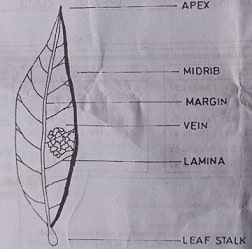
2. The likely reason why the student failed the test was that the
-
-
- A. labels were wrong and the guidelines were not touching the structures.
- B. net venation shown were few, rough, not properly drawn and wrongly placed.
- C. leaf was too tapered at the apex, the leaf stalk was too short and the shape of leaf was wrong
- D. leaf venation should have been parallel and the midrib should be thicker
-
3. Which other features of the diagram, if shown, would have earned the student more marks? The
-
-
- A. colour and size
- B. title and magnification.
- C. habitat and agricultural qualities of leaf
- D. spelling of label and length of midrib
-
The diagram below are illustration of forms in which a particular group of organisms exist. Study them and answer questions 4 and 5.
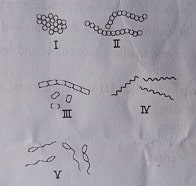
4. Which group of organism is illustrated?
-
-
- A. Bacteria
- B. Viruses.
- C. Fungi
- D. Protozoa
-
5. In which of the illustrated forms does the organism that causes cholera exist?
-
-
- A. II
- B. III
- C. IV
- D. V
-
Study the list of organisms below and use them to answer questions 6 and 7.
- I – Hydra
- II – Owl
- III – Snake
- IV – Snail
6. Arrangement of the organisms in order of increasing complexity is
-
-
- A. I – II – III – IV
- B. II – III – I – IV
- C. I – IV – III – II
- D. IV – III – II – I
-
7. The phylum of the organism labelled IV is
-
-
- A. Coelenterata
- B. Platyhelminthes
- C. Mollusca
- D. Arthropoda
-
The diagram below is an illustration of a cell in which photosynthesis takes place. Study it and answer questions 8 and 9.
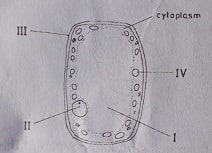
8. In which of the labelled parts would molecules of water and carbon (IV) oxide combine to form sugar?
-
-
- A. I
- B. II
- C. III
- D. IV
-
9. The oxygen gas formed in the cell diffuses out of the cytoplasm into the air spaces through the part labelled
-
-
- A. I
- B. II
- C. III
- D. IV
-
10. An example of a process that involves osmosis is the
-
-
- A. movement of digested food from ileum into blood capillaries
- B. translocation of starch from leaves to all parts of a plant
- C. reabsorption of food nutrients from the kidney into blood capillaries
- D. movement of water from root hairs into cortical cell
-
11. Growth in animals differs from that in plants because growth in
-
-
- A. plants is intercalary
- B. animals is apical
- C. plants is from within
- D. plants is indefinite
-
The diagram below is an illustration of a structure in the skeletal system of humans. Study it and answer questions 12 and 13
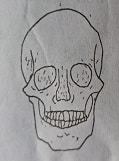
12. The illustrated structure is a part of the
-
-
- A. cervical vertebrae
- B. axial skeleton
- C. axis vertebrae
- D. appendicular skeleton
-
13. An individual was involved in a car accident and the illustrated structure was badly injured. Which of the following structures would most likely be affected?
-
-
- A. Lumbar, eye and teeth
- B. Ear, brain and hinge joint
- C. Eye, cerebellum and ear
- D. Clavicle, tongue and pelvis
-
14. The tricuspid valve is located between the
-
-
- A. left auricle and left ventricle.
- B. right auricle and the superior vena cava
- C. aorta and left ventricle
- D. right auricle and right ventricle
-
The diagram below is an illustration of some structures used for gaseous exchange in humans. Study it and answer questions 15 and 16.
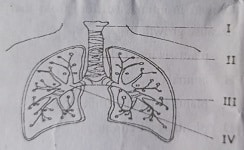
15. The parts labelled I, II, III and IV respectively are
-
-
- A. Larynx, bronchus, bronchiole and trachea
- B. bronchus, bronchiole, trachea and larynx
- C. bronchiole, trachea, bronchus and larynx
- D. larynx, trachea, bronchiole and bronchus
-
16. The part labelled III would be found in the
-
-
- A. heart
- B. lung
- C. kidney
- D. sternum
-
17. Which of the following hormones is wrongly paired with its secretory organ?
-
-
- A. Insulin and pancreas
- B. Oestrogen and ovary
- C. Oxytocin and hypothalamus
- D. Adrenalin and kidney
-
18. The eye detect caused by an uneven curvature of the cornea or lens or both is
-
-
- A. myopia
- B. astigmatism
- C. presbyopia
- D. hypermetropia
-
19. The androecium in a flowering plant is a collection of
-
-
- A. ovules
- B. stamens
- C. filaments
- D. sperms
-
20. Placentation in fruits is referred to as the
-
-
- A. part of the ovary where the ovules originate and remain till maturity.
- B. formation of a single carpel joined at the two edges of an ovule
- C. arrangement of ovules in the ovary of a flower
- D. ovules borne on a central column of tissues in an ovary.
-
21. Which of the following processes does not occur during photosynthesis?
-
-
- A. Carbon (IV) oxide is evolved
- B. Water is split
- C. Oxygen is evolved
- D. Energy from sunlight is absorbed
-
22. Stunted growth and small yellow leaves in plants are symptoms of the deficiencies of
-
-
- A. sulphur
- B. iron
- C. magnesium
- D. nitrogen
-
23. The structure that its action could result in choking when talking and eating at the same time is
-
-
- A. epiglottis
- B. oesophagus
- C. liver
- D. stomach
-
24. The food substance that would produce the highest amount of energy is
-
-
- A. glucose
- B. fat
- C. amino acid
- D. protein
-
25. Organisms that feed on dead, decaying tissues of other organisms are known as
-
-
- A. parasites
- B. autotrophs
- C. heterotrophs
- D. saprophytes
-
26. The type of nutrition in which organisms take in solid organic materials into their body is
-
-
- A. holozoic
- B. symbiotic
- C. saprophytic
- D. parasitic
-
27. The mouthparts of a grasshopper are adapted for
-
-
- A. chewing
- B. grinding
- C. sucking
- D. absorption
-
28. A group of organisms belonging to different species that coexist in the same habitat and interact is refered to as
-
-
- A. population
- B. biosphere
- C. niche
- D. community
-
29. Which of the following factors is the main problem facing xerophytes?
-
-
- A. Conservation of excess water
- B. competition for sunlight
- C. Lack of adequate water
- D. poor formation of roots
-
30. Fishes survive in water mainly because they posses
-
-
- A. streamlined body
- B. scales
- C. paired fins
- D. gills
-
31. Which of the following instruments in not used in measuring abiotic factors in a habitat?
-
-
- A. Thermometer
- B. Microscope
- C. Hygrometer
- D. Wind vane
-
32. Which of the following soil types have a high capillarity?
-
-
- A. sand and clay
- B. silt and clay
- C. silt and sand
- D. loam and sand
-
33. The capturing and digestion of insects by a pitcher plant is a special form of nutrition that is
-
-
- A. chemosynthetic
- B. saprophytic
- C. heterotrophic
- D. autotrophic
-
34. Which of the following organisms would be the producer in a food chain?
-
-
- A. Goat
- B. Maize
- C. Man
- D. Bacterium
-
35. The rate of decomposition of dead organisms is faster in the tropical rainforest than in other biomes because
-
-
- A. of consistent cool temperature
- B. of the relatively constant day light
- C. there are more plants
- D. of availability of moisture
-
The diagrams below are illustrations of organisms in a habitat. Study them and answer questions 36 and 37.
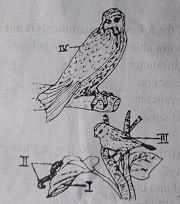
36. The feeding relationship between the organism labelled III and IV in the diagrams is
-
-
- A. mutualism
- B. parasitism
- C. predation
- D. saprophytism
-
37. The producer in the diagram is
-
-
- A. I because it contains the least amount of energy
- B. I because it uses sunlight to manufacture food
- C. IV because it is the largest organism in the diagram
- D. IV because it is the organism that receives the highest amount of sunlight
-
38. Which of the following activities is against the conservation of natural resources?
-
-
- A. Afforestation
- B. Deforestation
- C. Establishment of games reserves
- D. contour ploughing
-
Use the information below to answer questions 39 and 40
- I – making shoes from crocodile skin
- II – making tables with plastic
- III – using elephant tusk for decoration
- IV – using firewood for cooking
39. The act that should be encouraged for the conservation of wildlife and forests is
-
-
- A. I
- B. II
- C. III
- D. IV
-
40. In order to avoid some of the acts that would have negative effect on conservation, government should
-
-
- A. enact and enforce laws towards conservation of resources
- B. promote felling of trees without planting news ones
- C. encourage indiscriminate killing of wildlife
- D. encourage over-utilization of forest resources
-
41. Which of the following characteristics shows discontinuous variation in plants
-
-
- A. Colour of flower
- B. Height of plant
- C. Leaf size
- D. Fruit size
-
42. A Rhesus negative woman may experience stillbirth of the second child that is Rhesus positive because
-
-
- A. the woman is susceptible to diseases during pregnancy
- B. the blood of the focus might clump
- C. they have poor circulatory system
- D. the foetus is deprived of nourishment
-
43. A sudden change in the genetic composition of an organism is termed
-
-
- A. epistasis
- B. linkage
- C. mutation
- D. variation
-
44. Paternity disputes could be resolved accurately through
-
-
- A. finger printing
- B. blood group
- C. DNA test
- D. tongue
-
The illustration below is a genetic diagram study it and answer 45 to 47

45. What is the name of the genetic diagram
-
-
- A. Genetic
- B. Punnett square
- C. Inheritance diagram
- D. Genetic square
-
46. What do the labels I, II, III and IV respectively represent?
-
-
- A. EE, EE, EE and EE
- B. Ee, Ee, EE and Ee
- C. EE, EE, Ee and Ee
- D. EE, EE, Ee and ee
-
47. The genotypic ratio of the offspring in the genetic diagram is
-
-
- A. 1:1
- B. 1:2:1
- C. 1:3
- D.4:0
-
48. What is the probability that a pregnancy would result in a male child
-
-
- A. 1
- B. 3/4
- C. 1/2
- D. 1/4
-
49. A vestigial structure in human is
-
-
- A. gall bladder
- B. villus
- C. carlobe
- D. tail bone
-
50. The following activities are associated with termites except
-
-
- A. nuptial flight
- B. communication
- C. pollination
- D. searching for food
-
Recommended: Click here for more WAEC Past Questions

